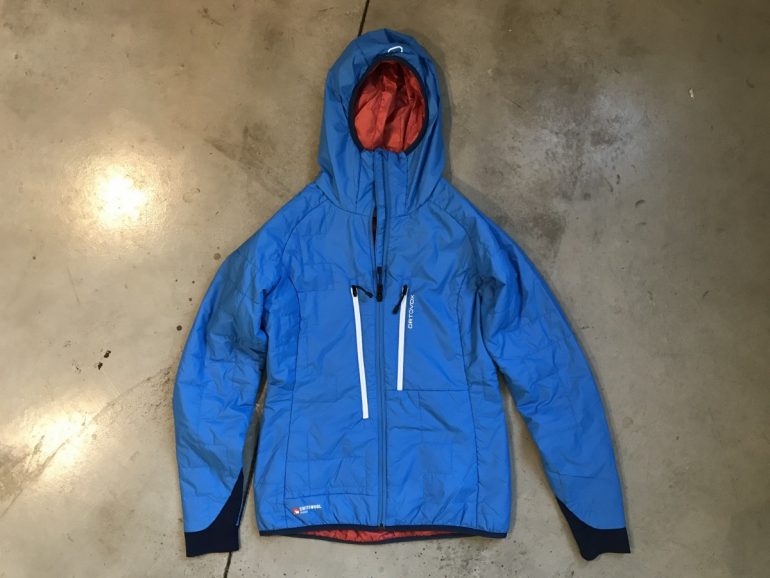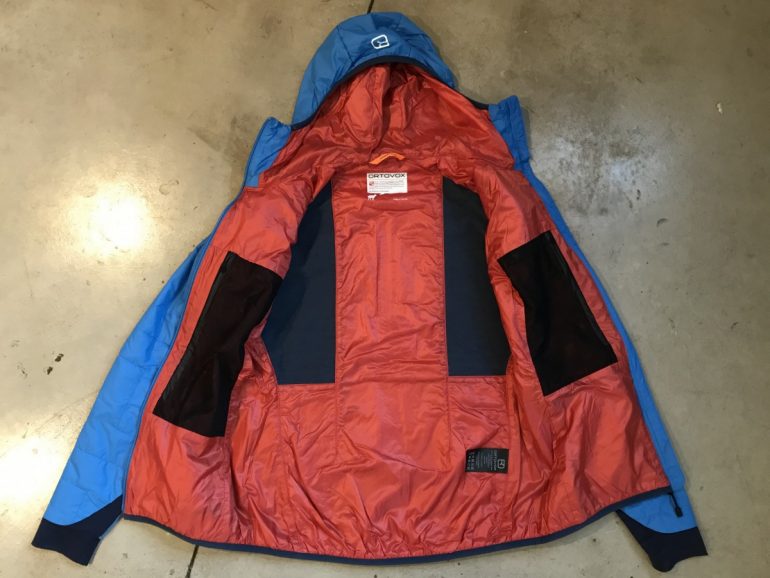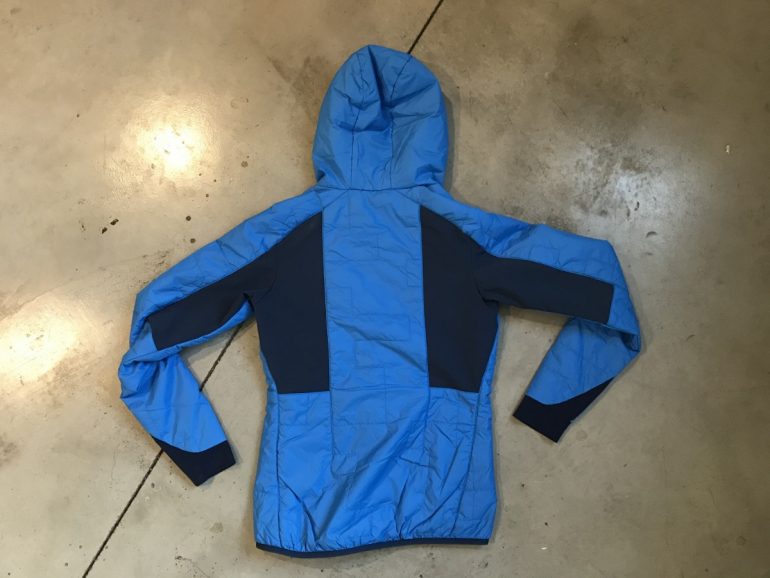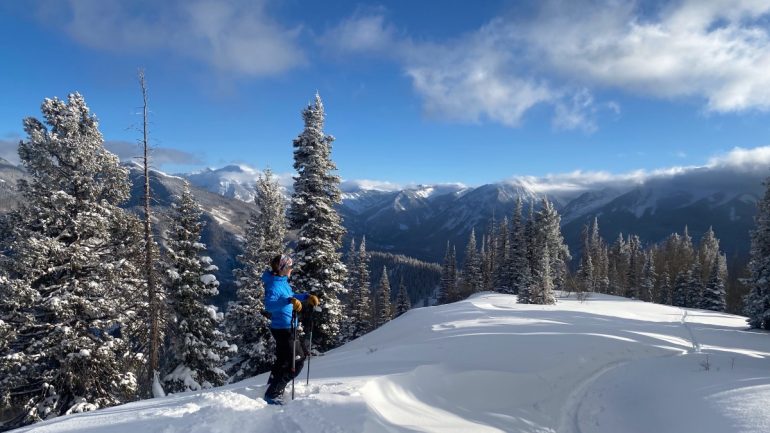
The Piz Boe Swisswool Jacket has proved a warm, weather resistant insulated layer for the up and down.
If the saying goes “when you have lemons make lemonade” perhaps it can be interpreted “when you have extended bouts of high pressure, retune your touring kit”. This winter in Colorado has certainly offered more than its fair share of those high pressure bouts. Even the more ‘secret’ of powder stashes were turning to mogul runs simply because of the long weeks passing between mild storms. And let’s not mention those snowpack layers so crookedly stacked I don’t want to look at them wrong, let alone go tromping.
That said, I’ve spent a lot of time doing long tours on mellow slopes and uphill workouts at the nearby ski areas this season. And on each groundhog day of bluebird and sunshine, the hardshell pants I typically tour in started to feel like overkill, as did my usual hardshell and down jacket combo. So this season I simplified the system and found some new standbys for my uphill kit: The Ortovox Col Becchei Pant and the Swisswool Piz Boe insulated jacket.
Col Becchei Softshell Pants
The Col Becchei Softshells are what Ortovox dubs their most athletic ski touring pant due to supreme breathability and freedom of movement. The pants feature Schoeller softshell fabric woven with merino to produce a piece that literally breathes with you — when the fabric is cold, the weave tightens. When you heat up, the fabric responds and the weave expands. It’s weather resistant on the outside but merino soft on the inside.
The pants also feature an elastic waistband, two hip pockets and a thigh pocket (large enough for phone and snacks, tight but elastic enough to stuff in a beacon), merino fabric patches on the backs of the knees and aramid reinforcements in the cuffs to prevent sharp edges from cutting in. Cuffs are elastic with zippers and snap buttons to accommodate a variety of boots.
So how do they perform?
I’ve got admit, on my first day in Col Becchei’s — a Thanksgiving skin up the then unopened Aspen Highlands area — I had my doubts. The fabric is heavier than I’m accustomed to and the inside merino layer felt too warm to expel heat fast enough. I shuffled to the top feeling a little sweaty and clammy, but not cold. On the ski down, the fabric breathability was palpable on my bare legs. Not unbearable, but noticeable.
Maybe at that point in the season I wasn’t quite fit and so was sweating extra, or maybe I just needed to adapt to the fabric. Whatever the case, I kept wearing the pants on my outings. I tried them on single-digit days to temps in the 30s, in bright high pressure sun and light falling snow. Overtime, I found the Col Becchei pants provided an ideal compromise: warm but not too warm, breathable enough for high output, weather resistant for getting caught in the snow (but not for too long), comfortable enough to wear all day…and even hang out for an episode or two of The Crown after (seriously, the inner merino layer is like a soft, warm hug).

The Piz Boe jacket and Col Becchei pants provided ideal warmth and breathability on 10 degree training days.
Fit
Lou mentioned in his previous pant review how the Euros know how to fit pants and I’ll second that. As an athletic woman, I don’t care to swim in boxy threads that look like they’ve been pulled out of my fiance’s closet, but I also don’t enjoy feeling like every curve on me is on display for fellow ski tourers to see. Ortovox nailed the fit on the Col Becchei — casual through the thigh, just enough boot cut to hug my Sportiva Sytron cuffs, and a fleece lined elastic waistband that never tells me I should lay off the post ski beers. I’ve also been told by said fiance that my butt looks good in them. Bonus.
Weather resistance
As mentioned earlier, it hasn’t snowed much (so far!) in Colorado this winter. Luckily I happened to be out skinning on a few occasions when it did. Melting snowflakes beaded on the schoeller fabric as expected, though on a particularly warm and snowy outing, I did notice a damp clamminess when I got back to the car. It seems there’s a temperature (and air moisture) limit to the fabric’s resistance to wetness, and in my experience, the fabric performs best on the high dry days. No matter, the rest of the occasions are what the Gore-tex is for.
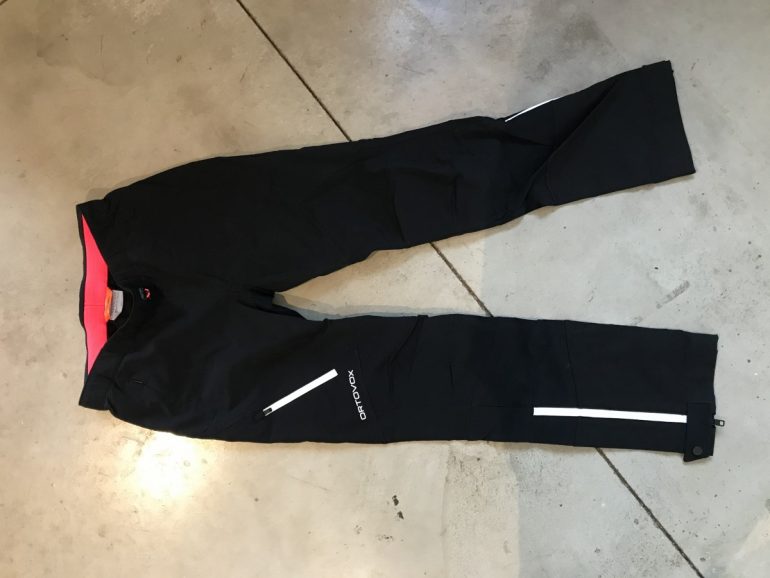
The Col Becchei pants — excellent breathability and mobility for long days during dry, high pressure systems.
Breathability
Two areas where the Col Becchei shine is in overall comfort and breathability. I’ve found that even in single digit temps, I don’t need a baselayer bottom if I’m moving consistently. Similarly, in warmer temps, I don’t need the vents that the pants don’t have. The permeability of the fabric is notable on ski descents, and that’s something to keep in mind. Since I spend at least 75% of my time going uphill on tours anyhow it hasn’t been a concern on any but the coldest of days. For colder, snowier, windier outings, I’d wear a light baselayer underneath.
Durability
After about 30 days of skinning, the pants show no signs of wear or pilling. The zippers and snap buttons work fine. The fabric hasn’t stretched in any unfavorable ways.
Piz Boe Swisswool Jacket
On the theme of wool, I often paired the Col Becchei pants with Ortovox’s Piz Boe Swisswool insulated jacket. It’s a a midlayer that is functional as it is sleek and doubles easily for long days out and a nice layer to wear around town. I first spotted the Piz Boe at OR last winter, on display in front of a massive poster featuring the wooliest sheep I’ve every seen. Once I got past the sheep poster, the jacket caught my eye for two other reasons: the attractive, athletic cut of it and its advertised Swisswool insulation (hence the sheep poster) — a different approach to midlayer filling often comprised of Primaloft, down or other synthetic varieties.
The Piz Boe is a lightweight, packable insulating layer. It features Pertex Quantum on the outside, a recycled tight weave fabric known to be highly abrasion and weather resistant. It’s insulated with raw Swisswool, a coarser cousin to merino that’s sourced from those charismatic sheep in the Alps. Swisswool maintains the characteristics merino made its name with — breathability and the ability to retain warmth when wet (according to Ortovox, it can absorb up to 35% of its own weight before feeling wet to the touch).
The jacket also features two offset chest pockets large enough for snacks, phone and other effects, but not quite enough for skins. It has an elastic hood though not helmet compatible, elastic waist and cuffs to keep in warmth, and underarm patches of stretchy Naturetec fabric (the same Schoeller/merino combo used in the Col Becchei).
So how does it perform?
I used the jacket in many same conditions as the Col Becchei pants, often together. Contrary to the pants though, I did find the jacket too warm to wear while skinning unless temps were below 20 degrees or just above and windy. In colder temps though — teens and single digits — it was warm and comfortable when paired with a grid fleece or 200 weight merino base layer. The outer fabric shed snow and didn’t soak through on the few days out with precip. It consistently maintained a comfortable and dry feel inside.
Where the jacket shined most was moments on summits or the tops of ski runs when I could tug it on and find immediate warmth and shelter from the wind. It was easy to move in while skiing down and heated up nicely when I stopped moving and started again. Also, the internal fabric has a delicious silky feel to it that means it sometimes even stays on to wear around the house (yes, sometimes while watching The Crown).
Fit
If I thought the Col Becchei was a nice, Euro fit, the Piz Boe feels actually tailor made, something I suspect other petit ladies will appreciate. It’s snug but not too much across the shoulders, the arms are the right length, the elastic waist fits just tight enough to keep the breeze out (and in between runs, my skins in) and it’s sleek. The under arm fabric patches give extra elasticity and freedom of movement. It’s worth pointing out that the jacket is an athletic fit, read: Body hugging, so if you like a little more looseness in your midlayer jackets, size up.
Weather resistance
Wind protection is noticeable and yet another reason it’s become more than just a skiing jacket. The Pertex Quantum outer layer resisted snow and light rain without soaking, though I haven’t yet tried it in wetter conditions. The beading of moisture I have seen so far is promising though.
Breathability
As mentioned above, the Piz Boe is most comfortable (e.g. breathes and insulates most effectively) while skinning only in colder temps. The wool insulation is just a bit too warm (and perhaps the Pertex too shielding) for the jacket to breathe well at higher temps and outputs. That said, for slower paced, cold midwinter days, I found it an ideal skinning layer. I could also see it working as a solid midlayer for ice climbing and alpine scrambling.
Durability
After roughly 30 days of touring and more around town, the zippers still pull, the fabric looks good as new and altogether no complaints. (Sidenote: on a recent morning I spilled smoothie down the front and was relieved to see the liquid pool on the outer fabric and easily wipe away rather than leaving behind blueberry colored streaks. Whew.).
Gripes
While I’ve loved most things about this jacket, a few things are worth noting.
One: the elastic around the wrists is so tight it’s tough to pull it back to get to my watch. Not a big deal, but inconvenient if I want to check the time quickly.
Two: Contrary to merino wool’s reputation as warding off stench, the jacket does have a smell after a few sweaty tours. Again, not a big deal but noticeable.
Three: While the elastic around the waist does stay put, it’d be nice to have a cinch pull in case I wanted to make it tighter or let it out.
So there you have it, an ideal kit for making the most of high pressure and low tide. The Col Becchei pants (which won an ISPO award last year) are my new go-to breathable, comfortable touring pant I’m happy to put on all days when it’s not puking snow. The Piz Boe jacket is a warm, well fitting layer for cool, slow moving days or the midlayer I’ll stash in my pack to throw on at the top.
Now if you’ll excuse me, it’s time to drink some lemonade and do another snow dance.
Note: the pants and jacket are available in men’s and women’s versions.
Shop for the Col Becchei pant
Shop for the Piz Boe jacket
Manasseh Franklin is a writer, editor and big fan of walking uphill. She has an MFA in creative nonfiction and environment and natural resources from the University of Wyoming and especially enjoys writing about glaciers. Find her other work in Alpinist, Adventure Journal, Rock and Ice, Aspen Sojourner, AFAR, Trail Runner and Western Confluence.

